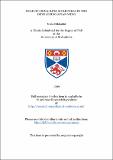Files in this item
Role of signalling molecules in the developing avian wing
Item metadata
| dc.contributor.advisor | McLachlan, John C. | |
| dc.contributor.author | Nikbakht, Neda | |
| dc.coverage.spatial | 205 p. | en_US |
| dc.date.accessioned | 2018-07-06T08:15:56Z | |
| dc.date.available | 2018-07-06T08:15:56Z | |
| dc.date.issued | 1999 | |
| dc.identifier.uri | https://hdl.handle.net/10023/15023 | |
| dc.description.abstract | The aim of this study was to investigate the role of signalling molecules during the development of the chick limb. First, it was demonstrated that a functional gradient of bioactive FGFs is present down the limb from distal to proximal. This functional FGF gradient decreased at stage 26, at the time of AER regression. Although morphogenetic gradients are of considerable theoretical importance in developmental biology, there are rather few practical demonstrations of their existence. The effects of prolonging the presence of active FGF on limb pattern formation were investigated. Application of ectopic FGF-4 to the distal tip of the limb at stage 26 had a number of effects on limb development. In particular, the cartilage structure conventionally labelled element "5" increased in size and in some instances acquired a digit-like morphology. The evolutionary considerations of this finding are briefly considered. Analysis, including 3D computer reconstruction, of the musculature and vasculature of limbs after FGF implants was carried out in the hope of establishing the identity of this digit like element. This proved not to be possible. However, both muscle mass and vascularisation had increased after the procedure. Known molecular pathways involving the proximo-distal patterning of the limb were then investigated. Whole mount in situ hybridisation studies were carried out with respect to FGF-4, sonic hedgehog, Hoxd-11 and FGF-8. These revealed that the shh/ FGF positive feedback loop was not involved in these changes. FGF-8 expression in late stage AERs was markedly increased. Hoxd-11 expression was not affected by ectopic FGF implants. Together, these findings suggest that the effect of FGF implants is mediated by a novel mechanism. The effect of FGF-4 implants on programmed cell death in the limb was examined. At stage 28 anterior necrotic zone was larger, and had shifted distally. However, the posterior necrotic zone was absent. The implications of these findings for limb development were discussed. | en_US |
| dc.language.iso | en | en_US |
| dc.publisher | University of St Andrews | |
| dc.subject.lcc | QL963.5N5 | |
| dc.subject.lcsh | Cell differentiation | en |
| dc.title | Role of signalling molecules in the developing avian wing | en_US |
| dc.type | Thesis | en_US |
| dc.type.qualificationlevel | Doctoral | en_US |
| dc.type.qualificationname | PhD Doctor of Philosophy | en_US |
| dc.publisher.institution | The University of St Andrews | en_US |
This item appears in the following Collection(s)
Items in the St Andrews Research Repository are protected by copyright, with all rights reserved, unless otherwise indicated.

